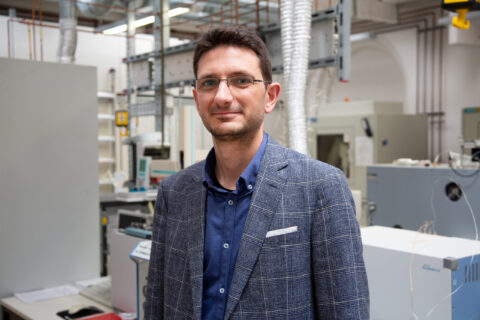Gabriele Chiogna investigates factors that influence water resources
As a physicist, Gabriele Chiogna is used to working on complex equations. However, it is not enough to understand how the availability and quality of water will change during the coming years. The answer to this problem varies greatly, depending on how we use this vital resource in the future.
“As modelers, we must always take decisions made by humans into account!”
Prof. Dr. Gabriele Chiogna investigates factors that influence water resources, also with the help of AI
Chiogna, who is a professor at Friedrich-Alexander-Universität Erlangen-Nürnberg (FAU) finds this aspect of his work particularly fascinating. With the aid of computer-assisted models, he would like to help decision makers to gain a better understanding of the consequences of different actions.
Climate change is changing rainfall patterns all over the world. This means that periods of drought are becoming longer and more pronounced in several regions. If rainfall occurs, it is often very heavy and only for short periods, which means the rain cannot seep into the soil but is carried away in streams and rivers. At the same time, our water consumption has also changed. We shower every day, water our gardens and lounge around the pool while on vacation. Water is therefore becoming a fiercely-disputed resource in many places, which can currently be seen in Sicily in Italy, Gabriele Chiogna’s home country, where it has hardly rained during the last year and a half. Farmers are even having difficulty finding enough water for their animals. Tourism is making the situation even worse. “Water management is extremely complex”, explains Professor Chiogna, who recently moved from TU Munich to the Professorship for Applied Geology and Environmental Systems Modeling at FAU. “The question as to how we should manage this resource involves not only ecological aspects, but also political, economic and social aspects.”
The perfect strategy doesn’t exist
This is because the various stakeholders have legitimate interests. Farmers are concerned that their harvest will dry out. Industry needs water for technical processes and thus indirectly to keep jobs. Humans need it for cooking, drinking and hygiene. “The perfect strategy doesn’t exist as far as managing water is concerned,”emphasizes Chiogna. “One measure used by industry may be damaging to the environment or vice versa.”
This may seem somewhat frustrating at first glance. However, for Chiogna, this is one of the aspects that makes his work so interesting. “We draw up models that enable us to illustrate the consequences of decisions. What do we set to gain when we take specific action? And what do we set to lose? In this way, we help decision makers to gain a better understanding of the consequences of different actions.”
Chiogna studied physics and applied geosciences in Tübingen and completed his habilitation in hydrology. “My expertise puts me at the interface between many different areas,” he says. “On the one hand, this background helps me to understand the processes that influence water quality and availability, and on the other, to develop models on this basis that we can implement in computer programs.”
How do solar parks influence water resources?
This software enables researchers to make certain prognoses. For example, how the groundwater level will develop in a region during the coming years, or also where landslides could occur after rainfall. “At the moment, we are investigating which effect solar parks have on water resources,” Chiogna explains. “The shade they create ensures less water evaporates. However, the rainfall is not distributed on the entire surface of the ground, but is concentrated on the gaps between the panels. This can lead to more erosion in these spaces and also to less water seeping into the ground.”
Weighting and mapping these processes correctly is no trivial task. Feeding the model into the software enables various future scenarios to be run through: What would happen if I built a solar park here? What would happen if I built it in another location that has different geological conditions? “This enables us to illustrate the effects of specific decisions,” says researcher Chiogna. We also strive to consider effects that arise from decisions that cannot be observed directly. For example, increasing energy prices can lead to more solar parks being built in a certain region. This would increase their impact on water resources accordingly. We try to predict such effects with machine learning – algorithms from artificial intelligence.”
The central aim of his research is to provide information and as objectively as possible. “We don’t make decisions ourselves, but generate predictions on which politicians can use as as a basis for taking action,” he emphasizes. “This means that we also state how certain or uncertain our predictions are. No matter how good our models are, they cannot predict the future with 100% certainty.”
Further information:
Prof. Dr. Gabriele Chiogna
Professorship for Applied Geology and Environmental Systems Modeling
Phone: + 49 9131 85 23042
gabriele.chiogna@fau.de
